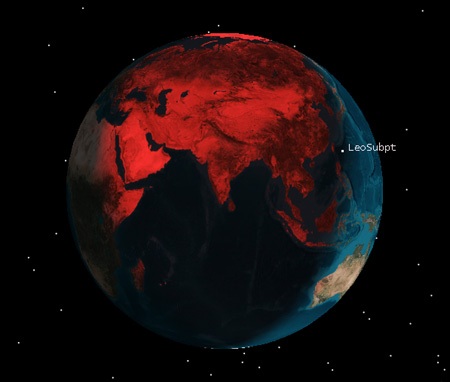This month, with darkness coming an hour earlier across most of the United States, all astronomically motivated eyes will be on the Leonid meteor showers, expected to peak around midmonth. If last year’s predictions are anything to go by, this year might be a pretty good year.
The Leonids are a result of Earth passing through the path of an old comet (55P/Tempel-Tuttle) whose tail littered our orbit over 500 years ago, in 1466, to be exact. A hundred years earlier, this comet made the third-closest approach to our planet of any known comet, only 0.0229 AU distant. Yikes! (An AU, or astronomical unit, for those of you who don’t know, is the average distance between Earth and the Sun; a shade under 93,000,000 miles or just a tad under 150,000,000 kilometers.)
Phil Plait, over at badastronomy, gets a charge out of this annual event:
I like the Leonids. The comet orbits the Sun in the opposite direction the Earth does, so we ram these guys head-on. That means they are moving much faster than regular meteors, which in turn means they really zip across the sky and burn up much brighter (the energy of motion depends on the velocity squared, so they pack a punch).
The Leonids should be active between November 10 and November 21, with peak activity occurring on November 17. Here is how NASA sums up this year’s activity:
In 2009 a very strong traditional maximum is expected. At 9 UT 17 November activity should rise to 25-30 meteors on ZHR scale. Also, at 21-22 UT 17 November a considerable outburst from 1466 and 1533 trails is likely. Activity will reach 130-140 meteors on ZHR scale, a number of submaximas is likely. Meteor brightness will be about average level. Another small enhancement can be produced by 1201 trail.
All the peaks in activity will be best visible from the areas marked in red below (image from NASA):
Unfortunately, as you can see, the closest observing site to south Florida for the peak activity is still about half a world away. And, while I like both astronomy and India, I’m not going to travel across the world near Thanksgiving just to get a better view of a nice meteor shower.
The great thing about meteor showers, though, is that they’re very hard to predict. So there’s always a chance of a good show on any night where we’re near the comet’s debris trail. So if you’re wandering late at night in an unlit area–first, be careful. And, second–look up! You might just see an amazing light show!
If you want to find out more about the Leonids, try this PDF from NASA’s public outreach people.



I’m sorely tempted to visit a hot springs in the mountains nearby and spend the night watching anyway. If only it were on a weekend.
I ran across your site by accident, while searching for information about the phrase vertebrate chauvinism. I definitely appreciated the blog about headless cockroaches and recently made a friend read The Metamorphosis after we learned that suspected bedbugs which nearly caused her a breakdown were nothing more than common carpet beetles.
So that’s by way of saying that I love astronomy and entomology and literature too and may stop back again.
Hey, glad you liked it! Feel free to come back any time.